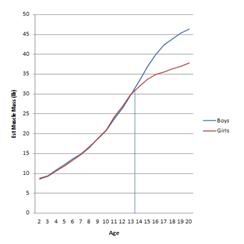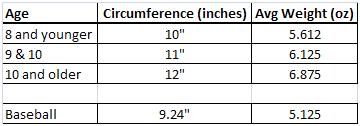 To a new Softball coach, the differences between Softball and Baseball are superficial. The ball is a little bigger and yellow instead of white. The pitching rubber is a little closer, but so are the fences. Oh yeah, and Softball is (typically) a girls’ sport and boys play baseball. However, the longer the Softball coach coaches, the more he appreciates that Softball really is a completely different sport than baseball, with its own style, tactics, and strategy. This article is the first in a series dedicated to exploring the differences between boys and girls and examining the techniques we teach our softball players. Here, we will look at the physical differences between male and females.
To a new Softball coach, the differences between Softball and Baseball are superficial. The ball is a little bigger and yellow instead of white. The pitching rubber is a little closer, but so are the fences. Oh yeah, and Softball is (typically) a girls’ sport and boys play baseball. However, the longer the Softball coach coaches, the more he appreciates that Softball really is a completely different sport than baseball, with its own style, tactics, and strategy. This article is the first in a series dedicated to exploring the differences between boys and girls and examining the techniques we teach our softball players. Here, we will look at the physical differences between male and females.The graph to the right plots the average amount of muscle mass of the sexes from age 2 to 20. For example, the average 10 year old girl has about 20 pounds of muscle mass (derived by taking her average weight and subtracting bone, organ, sugar, spice and cootie mass). Boys and girls have almost exactly the same average muscle mass until they turn 13 and puberty hits, where boys tend to add muscle mass a lot faster than girls. As a result, by the time women reach 20 years old, they have only about 82% of the muscle mass that men do at the same age.
 We have already mentioned that a softball is bigger than a baseball, but by how much? Different Softball leagues use different size balls at different ages, though by the time the softball player is in High School, she is definitely playing with a ball 12” in circumference and probably has for several years. My own rec league uses a 10” Softball for girls 8 years old and younger, an 11” ball for girls 9 and 10 years old, and a 12” ball for girls older than 10, so let us use that as a baseline. The table to the right shows the size and the weight of these softballs, and shows the size and weight of a baseball for comparison. As the reader can see, the 10” softball is close in size to a baseball, but as the girls get older, the softballs get bigger. Meanwhile, boys continue to play with the same size baseball.
We have already mentioned that a softball is bigger than a baseball, but by how much? Different Softball leagues use different size balls at different ages, though by the time the softball player is in High School, she is definitely playing with a ball 12” in circumference and probably has for several years. My own rec league uses a 10” Softball for girls 8 years old and younger, an 11” ball for girls 9 and 10 years old, and a 12” ball for girls older than 10, so let us use that as a baseline. The table to the right shows the size and the weight of these softballs, and shows the size and weight of a baseball for comparison. As the reader can see, the 10” softball is close in size to a baseball, but as the girls get older, the softballs get bigger. Meanwhile, boys continue to play with the same size baseball.  It is now instructive to compare player muscle mass to the ball that they use. Converting ball mass to pounds (so that it is the same unit as muscle mass), and then dividing player muscle mass by the mass of the ball with which they play results the ratio of player muscle mass to ball mass, and is plotted for ages 7 through 20 in the new graph to the right. Because of the heavier softball, women result in only 62% of the muscle/ball mass ratio that men do by the time they are 20 years old.
It is now instructive to compare player muscle mass to the ball that they use. Converting ball mass to pounds (so that it is the same unit as muscle mass), and then dividing player muscle mass by the mass of the ball with which they play results the ratio of player muscle mass to ball mass, and is plotted for ages 7 through 20 in the new graph to the right. Because of the heavier softball, women result in only 62% of the muscle/ball mass ratio that men do by the time they are 20 years old. This graph explains a lot to me as a Softball coach. As girls are young, they play with a ball that is similar in size to a baseball. Since girls also have the same average muscle mass, baseball techniques for hitting, bunting and throwing tend to work for the young softball player. It has been my experience, however, that those techniques that work well for the young softball player do not work as well as the player gets older – something that has always baffled me. Now I have a clue as to why. We will be exploring the implications of the physical differences between males and females and the corresponding different ball size in future articles.
BellaOnline Softball Subject List: Coach´s Box, Health & Medical, History of Softball, International Softball, Organizations, Parents , Professional Softball, Reviews, Rules & Regulations, Scorekeeping, Stats & Analysis, Travel Ball |


